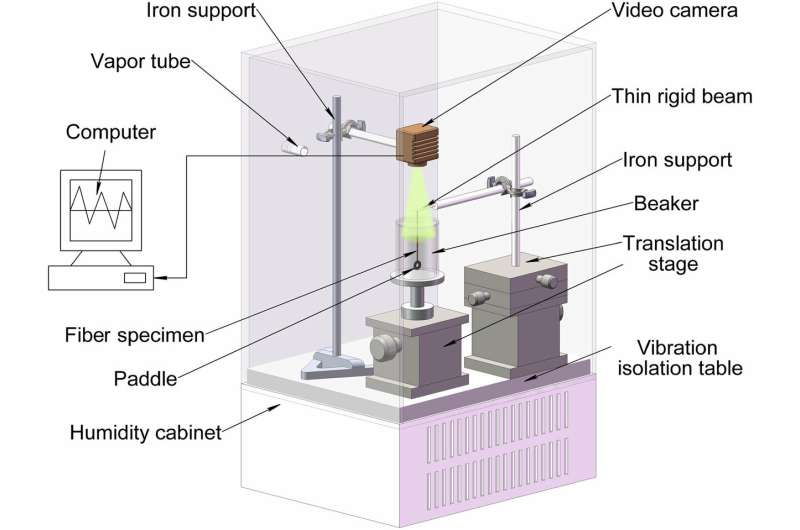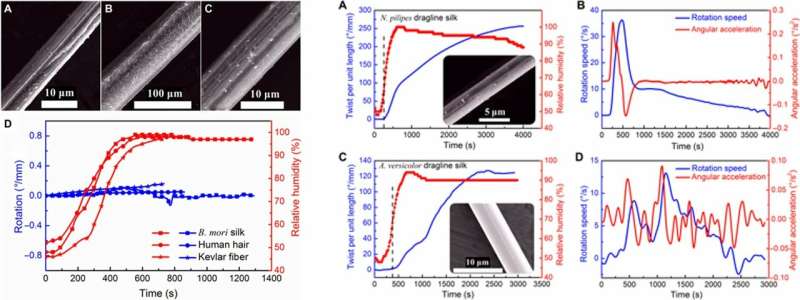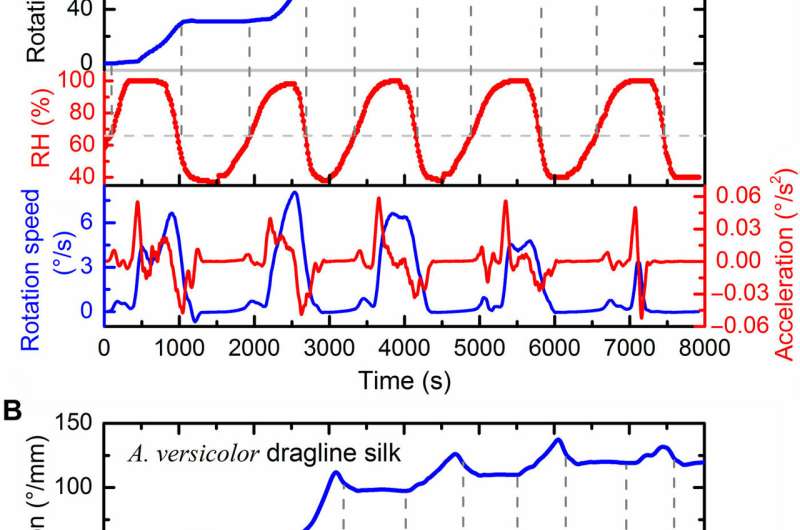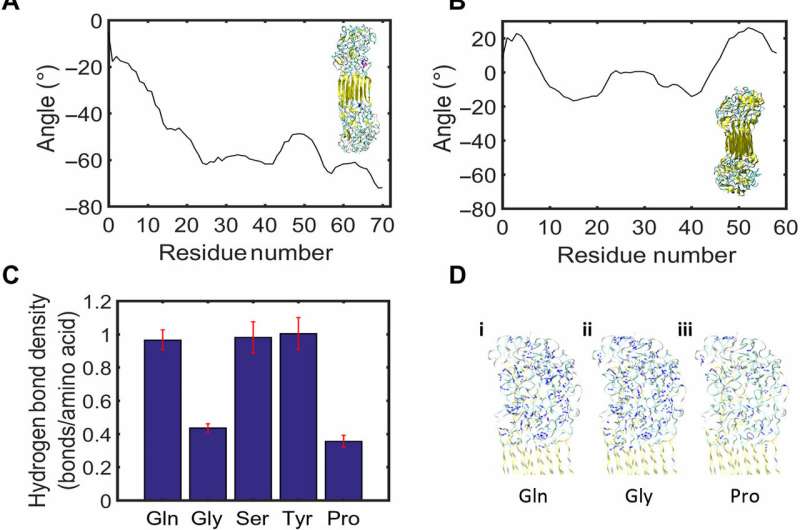

| Date | 7th, Mar 2019 |
|---|
 In the study, Liu et al. used dragline silks from the pictured spider species Nephila eduli, Nephila pilipes and Argiope versicolor. Image credit: Spider ID (spiderid.com/pictures/?fwp_attributes=webs) Credit: Science Advances, doi: 10.1126/sciadv.aau9183
In the study, Liu et al. used dragline silks from the pictured spider species Nephila eduli, Nephila pilipes and Argiope versicolor. Image credit: Spider ID (spiderid.com/pictures/?fwp_attributes=webs) Credit: Science Advances, doi: 10.1126/sciadv.aau9183
Spider silk is a self-assembling biopolymer with hydrogen bonds underlying its chemical structure, yet despite weak chemical bonding it outperforms most materials relative to mechanical performance. The biopolymer is produced from the spider major ampullate gland and is an extraordinary fiber that can surpass most synthetic materials in mechanical toughness by balancing strength and extension/flexibility. Properties of spider dragline silk include high thermal conductivity, peculiar torsion dynamics and the potential for exceptional vibration propagation. To add more distinction to the natural fiber, spider dragline silk display a giant shape-memory effect upon exposure to water; in an effect known as supercontraction. The unique and remarkable properties of spider dragline silk are attributed to its hierarchical structure and morphology.
In a recent study, now published in Science Advances, Dabiao Liu and co-workers at the multidisciplinary research fields of engineering, physics, molecular mechanics, biomedical engineering and life sciences, report on the new feature of humidity-induced torsional behavior of spider silk. They demonstrated the impact of spider dragline silk and possible structural origins of the torsional response in the study with potential to engineer a "whole new class of materials". Understanding the structure-property relationship of spider silk can benefit materials scientists by providing an impression of the precise physical nature of the biopolymer. New biomaterials based on the significant mechanical properties of spider silk can be engineered to translate the structure-property relationship of the material into practical applications.
Spider dragline silk material is sensitive to water and can shrink up to fifty percent in length with radial swelling. Water can disrupt hydrogen bonds at high humidity to rearrange the nanocrystalline molecules to lower energetic configurations, resulting in supercontraction. In applied sciences and engineering, supercontraction can find original applications as artificial muscles or tensile actuators. For instance, spider silk from Nephila clavipes and Ornithoctonus huwena can display a reproducible shrink-stretch behavior due to water and humidity, allowing cyclical weight lifting to occur. Recent examples of such applications include engineered torsional artificial muscles with synthetic polymers, carbon nanotubes and graphene-made fibers.
 Schematic diagram of the apparatus used to measure torsional actuation of silks or other fibers driven by the relative humidity (RH). Credit: Science Advances, doi: 10.1126/sciadv.aau9183
Schematic diagram of the apparatus used to measure torsional actuation of silks or other fibers driven by the relative humidity (RH). Credit: Science Advances, doi: 10.1126/sciadv.aau9183
Although previous studies have investigated torsional properties of spider dragline silk, structural origin of its torsional behavior remains to be explored in depth. In this work, Liu et al. observed the unique behavior of spider dragline silk in comparison to control fibers such as Bombyx mori silk, Kevlar fiber and human hair. The scientists designed the experiments to reveal the stepwise personal response of dragline silk to increased humidity. They conducted atomistic simulations of the two-component proteins MaSp1 and MaSp2 to understand the mechanism of structural twist behavior at the level of the molecule. They then proposed a possible relationship between the observed twist deformation driven by humidity and the molecular structure of dragline silk.
Liu et al. used dragline silks from Nephila pilipes, Nephila eduli and Argiope versicolor spider species by successfully replicating a previous method for silk sample collection. They used an apparatus based on image processing to study humidity-driven torsional actuation of the thin fibers. In the experimental setup, the scientists used a torsion pendulum made of a single fiber enclosed in a humidity cabinet and recorded the motion of the pendulum using a video camera while increasing or decreasing the relative humidity (RH). They designed two different protocols to understand the response of spider dragline silks to the changing humidity; one protocol increased the RH stepwise to maintain high values for a long period of time. In the second method, they cyclically changed the RH from 40 to 100 percent and returned to 40 percent five times.
 Left: SEM images of the fibers and the responses to environmental humidity stimulus. (A) B. mori silk (7.7 ± 0.3 μm in diameter). (B) Human hair (68.7 ± 2.5 μm in diameter). (C) Kevlar fiber (10.7 ± 0.2 μm in diameter). (D) Torsional responses of the representative fibers to environmental humidity: B. mori silk fiber (65.1 mm in length), human hair (69.5 mm in length), and Kevlar fiber (86.9 mm in length). A negligible twist driven by humidity can be seen in these fibers. Right: Torsional actuation of spider dragline silks by increasing the RH from 40 to 100%. (A) Torsional actuation of N. pilipes spider dragline silk (121 mm in length, 3.1 ± 0.1 μm in diameter). (B) Rotation speed (blue line) and angular acceleration (red line) of the torsional actuation of N. pilipes spider dragline silk. (C) Torsional actuation of A. versicolor spider dragline silk (87.9 mm in length, 6.7 ± 0.1 μm in diameter). (D) The rotation speed (blue line) and angular acceleration (red line) of A. versicolor spider dragline silk. Inset shows the SEM images of representative silks. Credit: Science Advances, doi: 10.1126/sciadv.aau9183
Left: SEM images of the fibers and the responses to environmental humidity stimulus. (A) B. mori silk (7.7 ± 0.3 μm in diameter). (B) Human hair (68.7 ± 2.5 μm in diameter). (C) Kevlar fiber (10.7 ± 0.2 μm in diameter). (D) Torsional responses of the representative fibers to environmental humidity: B. mori silk fiber (65.1 mm in length), human hair (69.5 mm in length), and Kevlar fiber (86.9 mm in length). A negligible twist driven by humidity can be seen in these fibers. Right: Torsional actuation of spider dragline silks by increasing the RH from 40 to 100%. (A) Torsional actuation of N. pilipes spider dragline silk (121 mm in length, 3.1 ± 0.1 μm in diameter). (B) Rotation speed (blue line) and angular acceleration (red line) of the torsional actuation of N. pilipes spider dragline silk. (C) Torsional actuation of A. versicolor spider dragline silk (87.9 mm in length, 6.7 ± 0.1 μm in diameter). (D) The rotation speed (blue line) and angular acceleration (red line) of A. versicolor spider dragline silk. Inset shows the SEM images of representative silks. Credit: Science Advances, doi: 10.1126/sciadv.aau9183
Using scanning electron microscopy (SEM), the scientists first characterized the morphology and structure of spider silks. They conducted screening tests on three control fibers; B. mori silk, human hair and Kevlar fiber. The experiments revealed the torsional responses of the representative fibers to environmental humidity. They then observed humidity-induced cyclic contractions/relaxations of dragline silk from different spider species to understand torsional actuation driven by humidity in dragline silk. After the tests, the surface of the dragline silk became rougher than at the initial stage. The spider dragline silk of N. pilipes achieved torsional deformation approximating 2550/mm in one direction, a value greater than that generated by carbon nanotube artificial muscles (2500/mm) powered by electricity. The value was also 1000 x greater than those reported for other actuators based on shape-memory alloy and conducting polymers with twist deformation ability. For the A. versicolor dragline silk, the torsional actuation started at 70 percent RH, this value was lower than that of N. pilipes dragline silk but still comparable to carbon nanotube muscles.
 Torsional actuation of dragline silks to RH cyclically changing from ~40 to ~100%. (A) N. pilipes dragline silk (98 mm in length, 3.1 ± 0.1 μm in diameter). (B) A. versicolor dragline silk (87.9 mm in length, 6.7 ± 0.1 μm in diameter). (C) N. edulis dragline silk (82 mm in length, 2.8 ± 0.1 μm in diameter). The horizontal dashed lines indicate the RH thresholds to trigger the twist. The vertical dashed lines indicate the start and end of the induced twist. Note that the rotation direction of clockwise direction observed from top to bottom paddle is consistent for all silk samples. Credit: Science Advances, doi: 10.1126/sciadv.aau9183
Torsional actuation of dragline silks to RH cyclically changing from ~40 to ~100%. (A) N. pilipes dragline silk (98 mm in length, 3.1 ± 0.1 μm in diameter). (B) A. versicolor dragline silk (87.9 mm in length, 6.7 ± 0.1 μm in diameter). (C) N. edulis dragline silk (82 mm in length, 2.8 ± 0.1 μm in diameter). The horizontal dashed lines indicate the RH thresholds to trigger the twist. The vertical dashed lines indicate the start and end of the induced twist. Note that the rotation direction of clockwise direction observed from top to bottom paddle is consistent for all silk samples. Credit: Science Advances, doi: 10.1126/sciadv.aau9183
Liu et al. then compared the results from the second protocol of cyclic humidity changes in which the spider dragline silk showed torsional response sensitive to humidity, providing a method to control twist deformation. As the number of RH cycles increased, the twist speed and angular acceleration of the dragline silk decreased, indicating that torsional deformation was reaching a state of saturation. The scientists recorded that all silks elongated by approximately 5 to 10 percent after each test.
Since humidity-induced twist is a unique characteristic of spider dragline silk, the scientists investigated the molecular structure and the morphology of the material to reveal the underlying mechanism of this behavior. They also analyzed the specific secondary structures and hierarchical structural organization of the molecule. Liu et al. showed that the presence of proline in the MaSp2 protein produced a more pronounced unidirectional twist at the scale of the single molecule. The scientists therefore assumed that the striated linear proline ring orientation may have forced the molecule into a twisted pattern. Using molecular simulation protocols at the protein level, they explained the observed glass transition behavior of spider silk at high RH.
 Mechanisms for humidity-induced torsion in dragline silks on a molecular level. (A) Representative angle displacement curve for MaSp2, showing consistent and negative angles traveling down the strands, which corresponds to clockwise twist. Inset shows molecular model of MaSp2. (B) Representative angle displacement curve for MaSp1, showing alternating positive and negative angles. Inset shows molecular model of MaSp1. (C) Hydrogen bond density scaled by the number of those residues present in the MaSp2 sequence. Proline shows the lowest hydrogen bond density compared to other residues. (D) Hydrogen bonds (shown in blue) within a 3-Å radius around (i) glutamine (Gln), (ii) glycine (Gly), and (iii) proline (Pro). (E) Hydrogen bond density scaled by end-to-end molecular length within a 3-Å radius around amino acids Glu, Gly, Ser, Tyr, and all amino acids in sequences MaSp1 and MaSp2. (F) Hydrogen bonds shown in blue in (i) MaSp1 and (ii) MaSp2 molecules. (G) Secondary structure content in MaSp1 and MaSp2. (H) The location of proline residues (with proline rings shown in red) in MaSp2 depicts a striated, linear ring orientation. Zoomed panel shows dotted guiding lines representative of linear proline ring orientation. Credit: Science Advances, doi: 10.1126/sciadv.aau9183
Mechanisms for humidity-induced torsion in dragline silks on a molecular level. (A) Representative angle displacement curve for MaSp2, showing consistent and negative angles traveling down the strands, which corresponds to clockwise twist. Inset shows molecular model of MaSp2. (B) Representative angle displacement curve for MaSp1, showing alternating positive and negative angles. Inset shows molecular model of MaSp1. (C) Hydrogen bond density scaled by the number of those residues present in the MaSp2 sequence. Proline shows the lowest hydrogen bond density compared to other residues. (D) Hydrogen bonds (shown in blue) within a 3-Å radius around (i) glutamine (Gln), (ii) glycine (Gly), and (iii) proline (Pro). (E) Hydrogen bond density scaled by end-to-end molecular length within a 3-Å radius around amino acids Glu, Gly, Ser, Tyr, and all amino acids in sequences MaSp1 and MaSp2. (F) Hydrogen bonds shown in blue in (i) MaSp1 and (ii) MaSp2 molecules. (G) Secondary structure content in MaSp1 and MaSp2. (H) The location of proline residues (with proline rings shown in red) in MaSp2 depicts a striated, linear ring orientation. Zoomed panel shows dotted guiding lines representative of linear proline ring orientation. Credit: Science Advances, doi: 10.1126/sciadv.aau9183
In this way, Liu et al. showed that spider dragline silk can generate a huge twist (up to 2550/mm for N. pilipes and 1270/mm for A. versicolor spider dragline silks) under 70 percent RH. The scientists showed that torsional actuation of the material could be controlled simply by tuning the level of the RH. The observed power generated in dragline silk was not passive but an active change of state in response to the driving force of humidity. The humidity-induced twist turned the dragline silk to act as a torsional actuator. These research findings will have applications in the development of humidity-driven soft robots, novel sensors of precise humidity, smart textiles or green energy devices.
More information: Dabiao Liu et al. Spider dragline silk as torsional actuator driven by humidity, Science Advances (2019). DOI: 10.1126/sciadv.aau9183
Sinan Keten et al. Nanostructure and molecular mechanics of spider dragline silk protein assemblies, Journal of The Royal Society Interface (2010). DOI: 10.1098/rsif.2010.0149
J. Foroughi et al. Torsional Carbon Nanotube Artificial Muscles, Science (2011). DOI: 10.1126/science.1211220
© 2019 Science X Network
Citation: Spider dragline silk as torsional actuator driven by humidity for applications as artificial muscle (2019, March 7) retrieved 21 August 2022 from https://phys.org/news/2019-03-spider-dragline-silk-torsional-actuator.html
This document is subject to copyright. Apart from any fair dealing for the purpose of private study or research, no part may be reproduced without the written permission. The content is provided for information purposes only.
